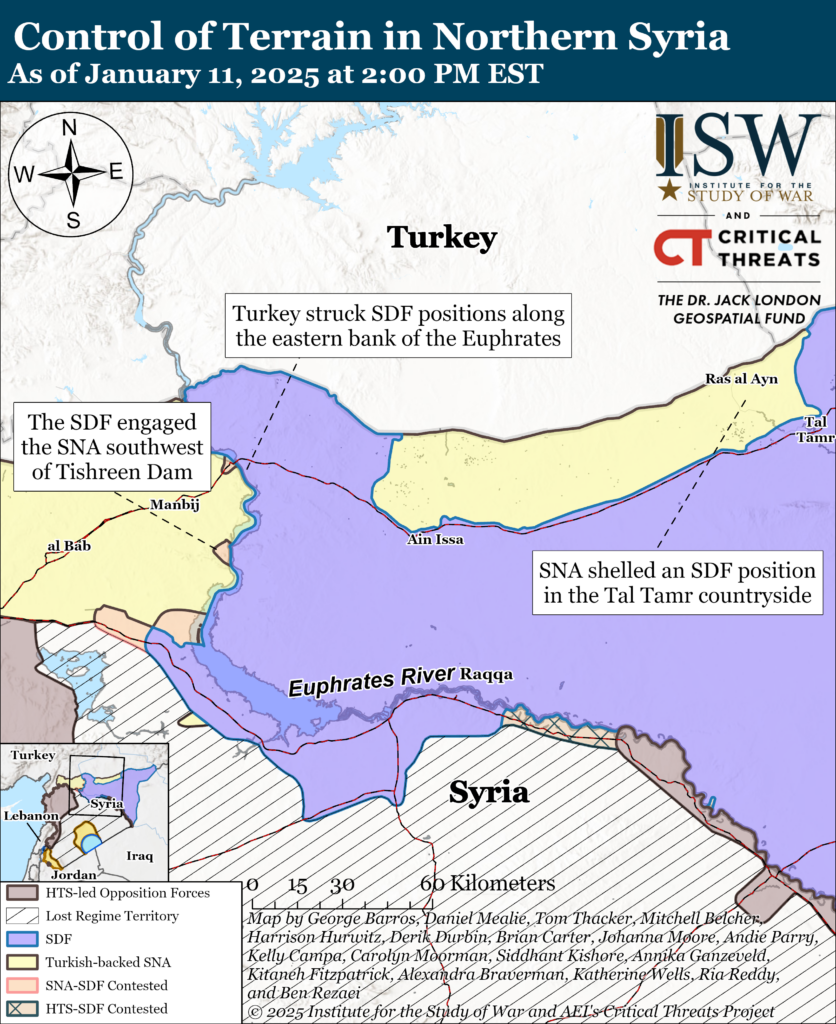
The Hayat Tahrir al Sham (HTS)-led Syrian interim government announced that it thwarted an attempted Islamic State of Iraq and Syria (ISIS) attack on a prominent Shia shrine outside Damascus. The Syrian Interior Ministry announced on January 11 the arrest of ISIS members who were planning a suicide bombing attack at the Sayyidah Zeinab shrine.[i] The ministry stated that the General Intelligence Directorate and General Security Administration coordinated to thwart the attack.[ii] ISIS has previously attacked Shia shrines in Syria, including in July 2023, when ISIS detonated a bomb near the Sayyidah Zeinab Shrine, killing six individuals and wounding 20 others.[iii] CTP-ISW cannot verify the interim government claim about the most recent attempted ISIS attack. If true, it would indicate that ISIS seeks to attack Shia targets to stoke sectarian tensions and delegitimize HTS as the primary ruling power in Syria. HTS announced recently that it has accepted responsibility for securing the Sayyidah Zeinab shrine.[iv]
HTS-led Syrian interim government officials met with a senior Lebanese delegation in Damascus to discuss border security, counter-smuggling efforts, and immigration on January 11.[v] HTS leader and interim head of state Ahmed al Shara and Foreign Affairs Minister Asaad al Shaibani met with a Lebanese delegation headed by Lebanese Prime Minister Najib Mikati.[vi] Shara said that they agreed to securing the border to prevent illegal smuggling as a top priority.[vii] Such efforts could impede Lebanese Hezbollah efforts to reconstitute militarily. Hezbollah has long relied on Syria as a conduit to receive funds and materiel from Iran. Hezbollah Secretary General Naim Qassem acknowledged that Hezbollah had lost its ground access to Iran via Syria and signaled his willingness to restore this connection with the support of the new interim government in Syria in December 2024.[viii] The border policies that the HTS-led interim government and Lebanon enact in the coming months will determine how easily Iran can revive its ground access to Hezbollah.
The Iraqi Army and Popular Mobilization Forces (PMF) launched an operation targeting the Islamic State of Iraq and Syria (ISIS) in the Hamrin Mountains, Diyala Province. The Iraqi Air Force conducted an airstrike on January 10 that killed four ISIS members.[ix] Iraqi Army Chief of Staff Lieutenant General Abdul Amir Rashid Yarallah visited the site of the airstrike on January 11.[x] The PMF announced on January 11 that the Iraqi Army and PMF Diyala Operations Command launched a security operation under the direction of Iraqi Prime Minister Mohammad Shia al Sudani to “clear and search” the Hamrin Mountains.[xi] The Diyala Operations Commander, Talib al Musawi, is affiliated with the Badr Organization and the Badr-controlled PMF 1st, 4th, 23rd, and 24th brigades all operate in Diyala.[xii]
The security operation in Diyala Province comes after Islamic Revolutionary Guards Corps (IRGC) special operations forces conducted military exercises in neighboring Kermanshah Province, Iran, between January 4 and 9.[xiii] The Gilan Province-based Mirza Kuchak Khan Special Forces Brigade and Saberin Special Forces Brigade participated in the exercises.[xiv] IRGC Ground Forces Commander Brigadier General Mohammad Pakpour stated on the sidelines of the exercise that Diyala Province was previously a “cradle of terrorist and Takfiri groups.”[xv] The exercises and Pakpour’s statement highlight heightened concerns among Iranian officials over external threats, particularly the possibility of ISIS infiltrations into Iran.
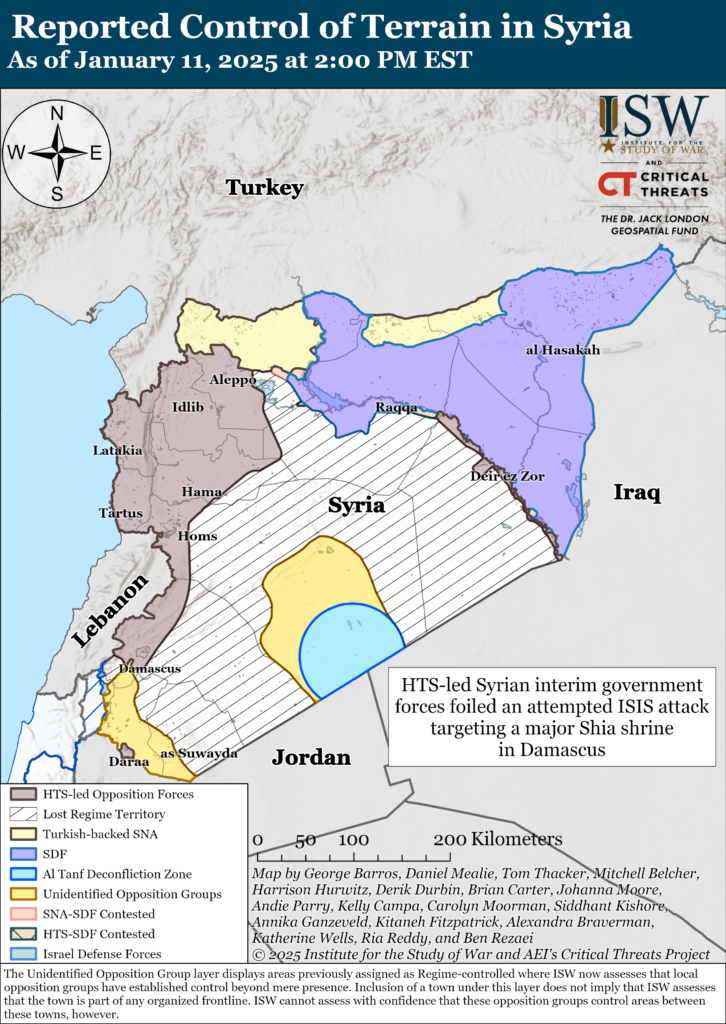
Key Takeaways:
Syria: The HTS-led Syrian interim government announced that it thwarted an attempted ISIS attack on a prominent Shia shrine outside Damascus.
Syria: The HTS-led Syrian interim government hosted a senior Lebanese delegation to discuss border security, counter-smuggling efforts, and immigration.
Iraq: The Iraqi Army and PMF launched an operation targeting ISIS in the Hamrin Mountains in eastern Iraq.
Syria
Axis of Resistance objectives:
Reestablish ground lines of communication through Syria to Lebanon
Reestablish Iranian influence in Syria
The Turkish-backed Syrian National Army (SNA) reportedly shelled US-backed Syrian Democratic Forces (SDF) positions along the eastern frontline amid indications of a possible SNA offensive against the SDF. Local, anti-SDF media reported that the SNA shelled an SDF position in the Tal Tamr countryside after CTP-ISW’s data cutoff on January 10.[xvi] Local reports also claimed that the SNA and SDF “clashed” south of Ras al Ain.[xvii] The reported SNA shelling comes amid possible SNA deployments and preparations for an offensive into SDF-controlled territory.[xviii] CTP-ISW cannot verify the local reporting about shelling or clashes along the frontline, however.
Turkey continued to support SNA operations to isolate SDF elements along the Euphrates River ahead of the possible offensive. Turkey conducted several airstrikes targeting SDF positions near Sarrin and along the eastern bank of the Euphrates River on January 11, according to local media.[xix] These strikes are likely meant to undermine SDF defenses against the SNA along the Euphrates River and the SDF ability to defend against a potential SNA offensive from Peace Spring territory.
The SNA continued to engage the SDF near the Tishreen Dam on January 11. An Arab source reported that the SDF engaged the SNA in two villages southwest of the Dam.[xx] The SNA targeted SDF positions near the dam with artillery.[xxi] The SNA posted footage confirming that it took control over a key hill near the dam that allows it to fire on SDF positions.[xxii] Commander of the Suleiman Shah Brigades—a faction affiliated with the SNA—Abu Amsha claimed on January 10 that the SNA took the hill.[xxiii]

The Israel Defense Forces (IDF) continued to operate in Quneitra Province on January 11. Local Syrian sources posted footage of Israeli bulldozers near al Malgah village.[xxiv] Israeli bulldozers also paved a road near al Rafid for several hours.[xxv]
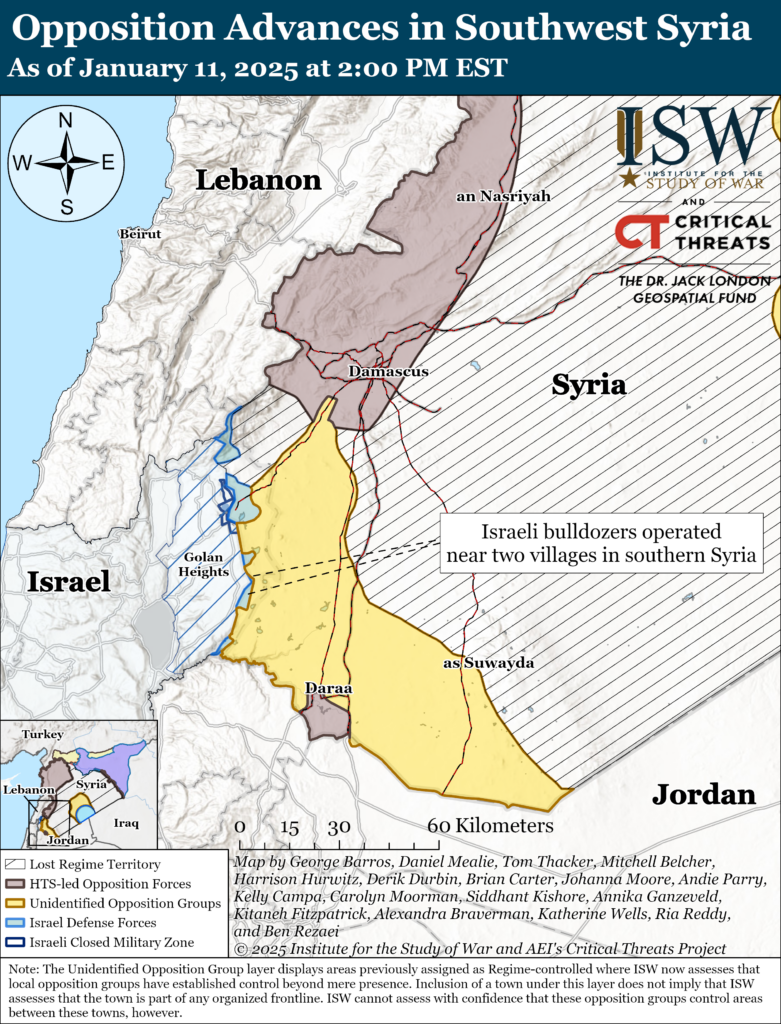
Iraq
Axis of Resistance objectives:
Strengthen Iranian and Axis of Resistance influence over the Iraqi state and society
Harden the Iraqi government against internal dissent
Iraq is continuing to bolster border security following the fall of the Bashar al Assad regime in Syria. The Iraqi Interior Ministry announced on January 11 that Iraqi security forces have extended the border wall between Iraq and Syria by 83 kilometers, increasing the total length of the wall to around 400 kilometers.[xxvi] Iraq seeks to extend the wall by another 215 kilometers.[xxvii] The construction of the border wall is consistent with recent Iraqi military deployments to the Iraq-Syria border in order to prevent ISIS and other external threats from destabilizing Iraq.[xxviii]
Arabian Peninsula
Axis of Resistance objectives:
Harden the Houthi regime against internal dissent in Houthi-controlled areas
Destroy the anti-Houthi opposition in order to control all of Yemen
Erode Israeli will to continue the war in the Gaza Strip
Nothing significant to report.
The Palestinian Territories and Lebanon
Axis of Resistance objectives:
Erode the will of the Israeli political establishment and public to sustain clearing operations in the Gaza Strip
Reestablish Hamas as the governing authority in the Gaza Strip
Rebuild and reestablish Hezbollah in southern Lebanon
Establish the West Bank as a viable front against Israel
The Gaza Strip
The IDF Air Force conducted an airstrike targeting Hamas fighters in a former school in Jabalia, northern Gaza Strip, on January 11.[xxix] The IDF reported that Hamas used the school to plan and conduct attacks targeting Israeli forces and territory.[xxx]
The Martyr Abu Ali Mustafa Brigades and Nasser Salah al Din Brigades launched rockets targeting the IDF along the Netzarim Corridor on January 11.[xxxi]
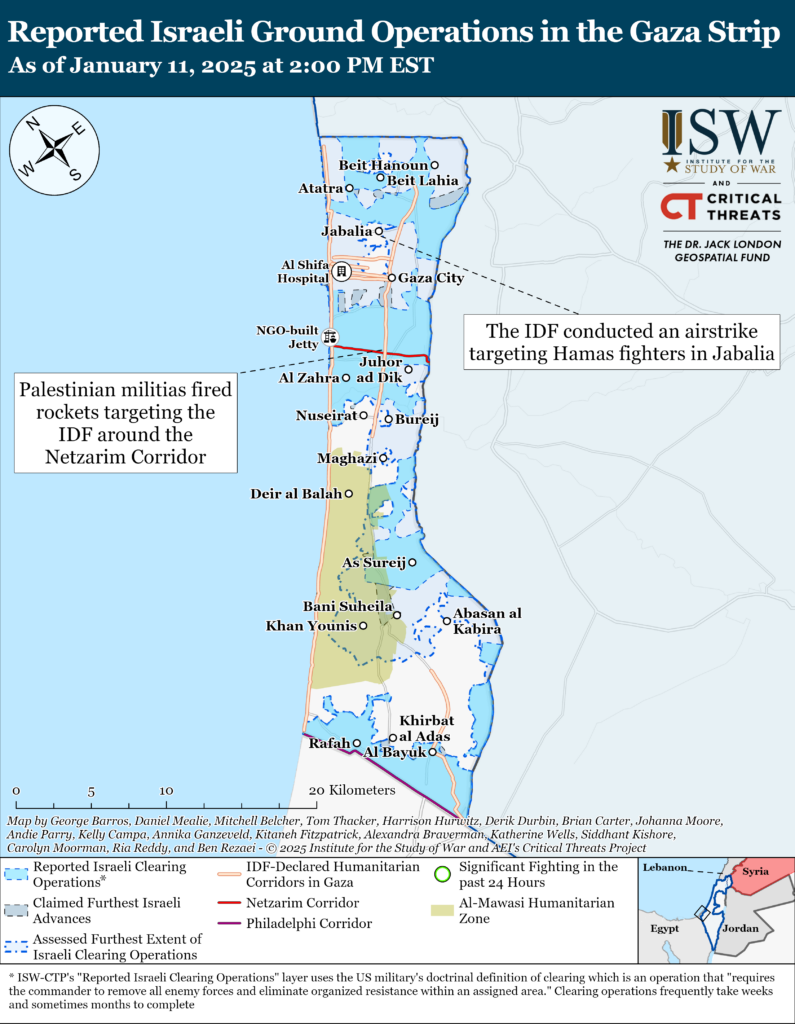
The IDF intercepted a rocket launched from the southern Gaza Strip near Kerem Shalom on January 11.[xxxii] No Palestinian group has claimed responsibility for the attack at the time of this writing.
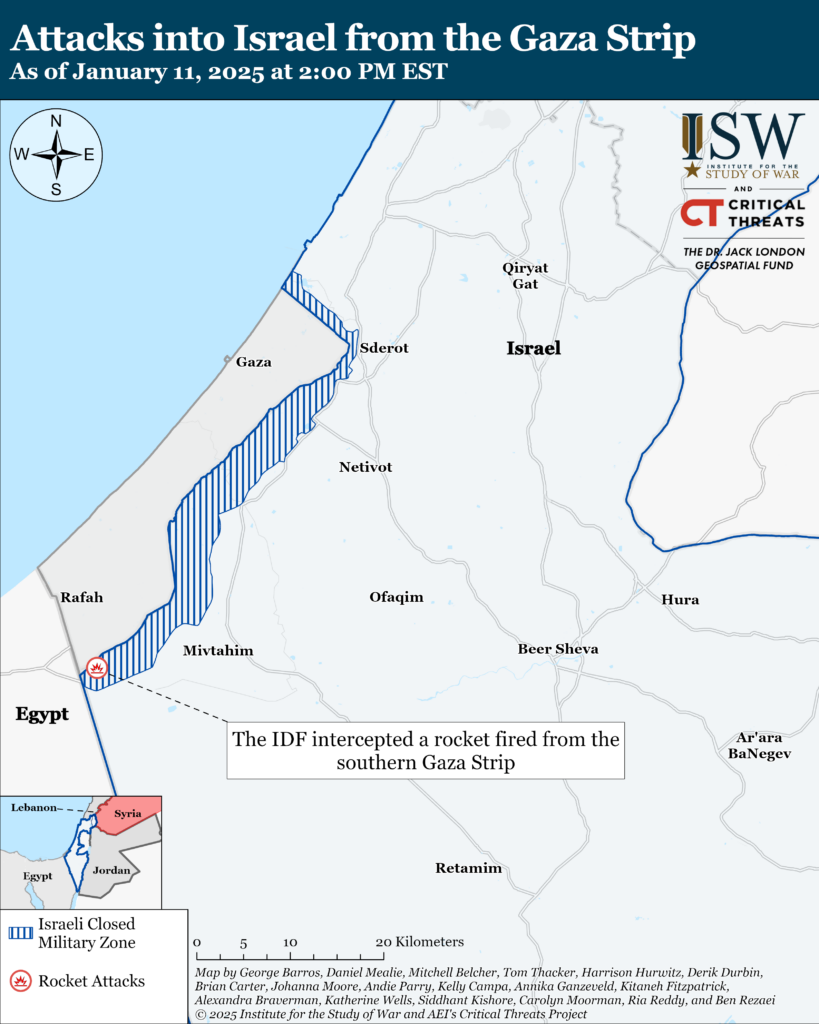
US President-elect Donald Trump’s Middle East Envoy, Steve Witkoff, traveled to Israel on January 11 to pressure the Israeli government to conclude a ceasefire and hostage-prisoner exchange deal with Hamas before January 20, according to Israeli officials speaking to Axios.[xxxiii] Witkoff told the Qatari prime minister on January 10 that Trump wants Israel and Hamas to conclude a ceasefire and hostage-prisoner exchange deal “within days,” according to an unspecified senior Israeli official. Israeli Prime Minister Benjamin Netanyahu ordered Mossad Director David Barnea, Shin Bet chief Ronen Bar, and Israeli negotiator Nitzan Alon to “immediately” travel to Doha to try to conclude a deal after meeting with Witkoff on January 11.[xxxiv]
An unspecified Hamas source told UK-based, Qatari-owned media on January 11 that Hamas has approved the “final visualization” of a ceasefire and hostage-prisoner agreement and is waiting for Israel to approve the agreement.[xxxv] The first phase of the agreement reportedly involves the withdrawal of the IDF from the Netzarim Corridor to east of the Salah al Din Road and from the Philadelphi Corridor to east of the Rafah border crossing. Under the agreement, the IDF would completely withdraw from the Philadelphi Corridor on the last day of the third phase of the agreement. A Hamas source claimed that Hamas agreed to resolve unspecified, unresolved “contentious issues” in a later phase of the agreement.[xxxvi]
Lebanon
The IDF Air Force conducted a drone strike targeting Lebanese Hezbollah fighters in Kounine, southeastern Lebanon, on January 11.[xxxvii] The IDF identified the fighters leaving a Hezbollah military building. Israeli media reported several injuries.[xxxviii]
Lebanese media reported that the IDF detonated explosives in Aita al Shaab and Yaroun on January 11.[xxxix]
The Lebanese Armed Forces (LAF) began to deploy to towns in Bint Jbeil district in southern Lebanon on January 11.[xl] The LAF reported that its units were deploying to Aitaroun and Bint Jbeil in southeastern Lebanon. Lebanese media previously reported that LAF armor entered Aitaroun on January 10.[xli] The IDF last reportedly operated in these areas on January 6.[xlii] The LAF also reported that its units were deploying to Ramyeh, Qouzah, and Salhanah in southern Lebanon.[xliii] The IDF last reportedly operated in these areas on January 7.[xliv]
The LAF continued to deploy to towns in Tyre district in southwestern Lebanon on January 11.[xlv] The LAF reported that LAF forces were deploying to Naqoura, Ain al Zarqa, al Batishiyeh, Dhayra, Aalma el Chaeb, Tayr Harfa, and Majdal Zoun. The LAF announced on January 7 that the LAF began deploying to Naqoura, Aalma el Chaeb, and Tayr Harfa after the IDF withdrew from these villages.[xlvi] The IDF last reportedly operated in these areas on January 6.[xlvii]
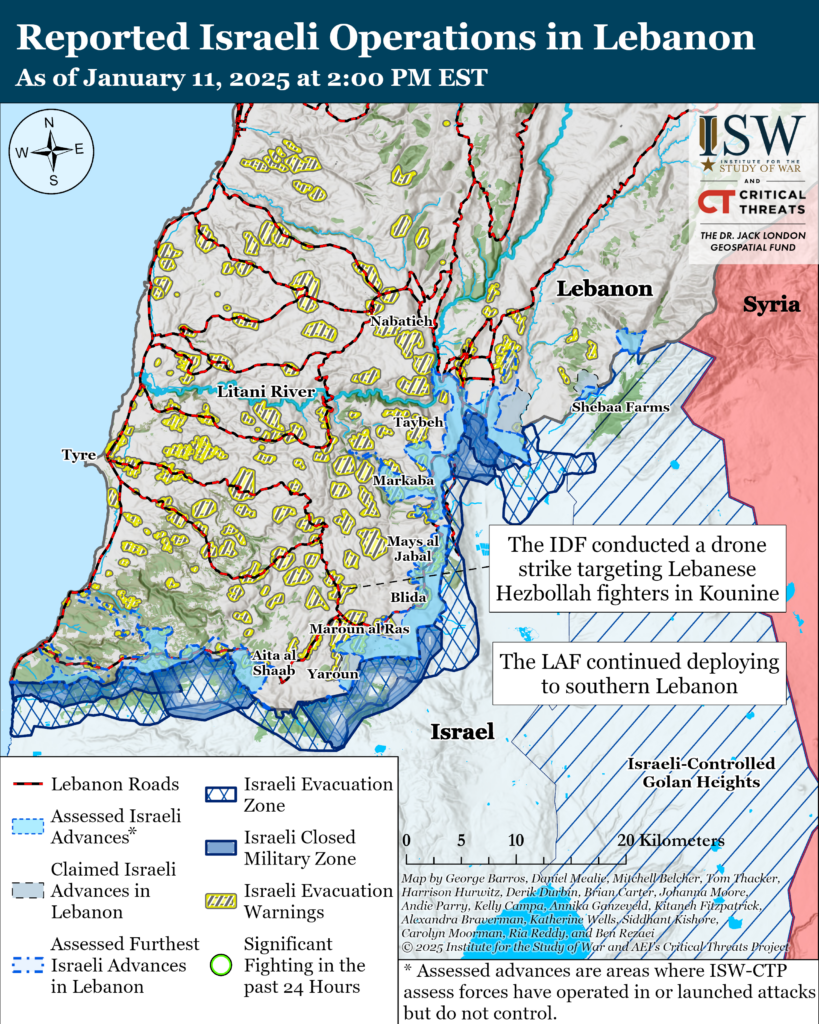
West Bank
Israeli media reported clashes between Israeli settlers and Palestinians in Yatma, Nablus Governorate, and Turmus Ayya, Ramallah and al Bireh Governorate, in the West Bank on January 11.[xlviii] Participants in the clashes threw stones and fired small arms at each other.[xlix] Israeli media reported that one Palestinian was wounded in Yatma.[l] These clashes follow an uptick in Israeli settler violence in recent days after Palestinian militia fighters killed three Israelis and wounded eight others in a shooting attack targeting vehicles on Route 55 in Qalqilya Governorate on January 6.[li]
Iranian Decision-Making, Internal Dynamics, and Foreign Policy
The Islamic Revolutionary Guards Corps (IRGC) Khuzestan Province Unit claimed that it identified and arrested a spy network linked to the intelligence services of an unspecified Persian Gulf country on January 11.[lii] The IRGC claimed that the arrested individuals gathered sensitive information from critical sites in Khuzestan Province. The IRGC has transferred the suspects to judicial authorities.[liii]
Iran shut down government offices and educational centers in around 22 provinces on January 11 due to energy shortages caused by a spike in gas consumption and increased electricity usage.[liv] The shutdowns occurred despite weather reports indicating rising temperatures rather than a decrease.[lv] The energy crisis has also sparked concerns over increased fuel consumption, with officials pointing to rising gas use in households and limited energy production capabilities.[lvi] Iranian media reported that educational centers in several provinces will be closed on January 12.[lvii] CTP-ISW previously assessed that the energy crisis could generate internal unrest in Iran.[lviii] Iranian Judiciary Chief Gholam Hossein Mohseni Ejei recently ordered Iranian security forces to prepare for potential unrest in late December 2024.[lix]
